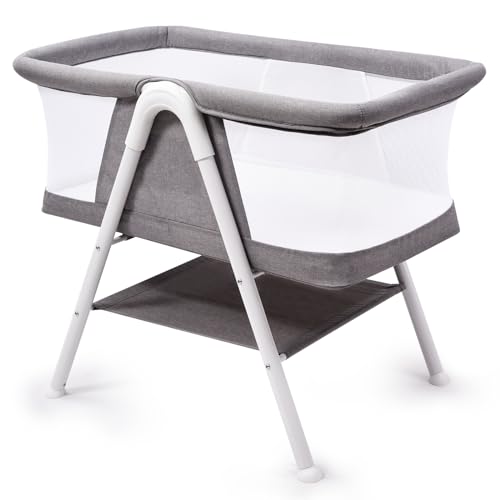How To Explain Bedside Cot For Co-Sleeping To Your Grandparents
The Benefits and Considerations of Bedside Cots for Co-Sleeping
Co-sleeping has actually become a popular choice for lots of new parents who seek to maintain close proximity to their infants during the night. Along with conventional co-sleeping practices, bedside cots are gaining traction as an option that provides both the comfort of nearness and the safety of different sleeping spaces. This article aims to check out the idea of bedside cots for co-sleeping, highlighting their benefits, potential disadvantages, pointers for choice, and common concerns.
Understanding Bedside Cots
Bedside cots, also referred to as side-sleepers or co-sleepers, are specially developed cribs that are attached to the side of the parents' bed. They permit parents to preserve easy access to their infants in the evening while offering a separate sleeping location that can enhance security and convenience.
Features of Bedside Cots
- Size and Design: Bedside cots are typically smaller sized than basic cribs however still provide sufficient room for an infant. The majority of models have adjustable heights to match the bed.
- Side Panels: Many models feature removable or mesh side panels that allow for safe visual monitoring of the baby, boosting parents' capability to react to their baby's requirements quickly.
- Stability and Safety: Bedside cots are built with stability in mind, featuring safety anchors or straps that protect the cot to the parent's bed.
- Relieve of Access: Parents can quickly reach over to comfort or feed their baby without having to rise, assisting in nighttime breastfeeding or relaxing.
Benefits of Using Bedside Cots for Co-Sleeping
- Improved Bonding: Proximity to the baby cultivates emotional connection and bonding, which is vital throughout the early stages of development.
- Easier Nighttime Care: Nighttime feeding and soothing become significantly simpler with a bedside cot, as parents can merely lean over to participate in to their baby's needs.
- Increased Safety: Bedside cots reduce the risk of suffocation or unexpected rolls that can occur with traditional co-sleeping directly in the parental bed.
- Specific Sleep Space: The documentation supports that having their own sleeping space can assist infants sleep better in terms of fewer disruptions from parents.
- Transitioning: A bedside cot can be a useful transitional tool as babies grow and start to transfer to their own rooms.
Feature
Advantages
Improved Bonding
Closer physical presence
Easier Access
Quick response to requirements
Increased Safety
Reduced danger of mishaps
Private Space
Less disruption at night
Streamlined Transition
Easier relocate to independent sleeping
Factors to consider Before Choosing a Bedside Cot
While bedside cots provide many advantages, prospective users ought to consider the following aspects:
- Size of Bed: Ensure that the cot fits nearby to the bed without causing discomfort or overcrowding.
- Spending plan: Prices can vary considerably among various brands and models, so think about budget plan restrictions carefully.
- Safety Standards: Check that the cot meets all security regulations to guarantee it is devoid of dangerous products and includes required safety functions.
- Material: Non-toxic surfaces and products are most importantly essential for infant health.
- Infant's Age and Weight: Some cots have weight limits, and parents must choose appropriately based on their baby's growth.
Tips for Selecting a Bedside Cot
- Check out Reviews: Look for user feedback and safety ratings.
- Look for Certifications: Ensure the cot abides by safety standards.
- Examine the Design: Choose a design that complements your bed room style while making sure functionality.
- Consider Accessibility: Look for models that enable easy reach however lessen the threat of presenting.
- Test Stability: Ensure that the cot is steady and safe and secure when connected to the bed.
Typical FAQs About Bedside Cots for Co-Sleeping
Q1: Are bedside cots safe for co-sleeping?
A1: When utilized properly, bedside cots are created to supply a safe sleeping alternative for infants while enabling close proximity to parents. Always ensure to protect the cot correctly to avoid motions that might cause accidents.
Q2: At what age can I begin utilizing a bedside cot?A2: Many parents begin using bedside cots right after the baby is born. However, Bedside Cot Bed For Newborns is important to talk to a healthcare company regarding your infant's readiness for co-sleeping, especially if they were born too soon. Q3: Can I use a regular
**crib for co-sleeping? A3: While routine cribs can be used, they do not offer the very same level of accessibility and safety as bedside cots, making bedside choices more beneficial for co-sleeping. Q4: What if my baby rolls over?A4: Most bedside cots are developed with safety functions that lessen threats if a baby rolls. Additionally,
they are usually low enough that a roll would not lead to a significant drop. Q5: How do I shift my baby from a bedside cot to a regular crib?A5: Gradually move your baby to a separate crib in their own room after they end up being familiar with oversleeping the bedside cot. Start with naps in the crib while maintaining nighttime co-sleeping till they adjust. Bedside cots provide a practical and safer alternative to direct co-sleeping, supplying various benefits in regards to benefit and safety. They assist in bonding
between infants and parents while reducing the risks associated with standard co-sleeping practices. Parents searching for a method to keep their babies close in the evening must think about the benefits that bedside cots can use. With a cautious evaluation of alternatives readily available, parents can produce a safe and comfortable sleep environment that supports their family's distinct requirements.  **
**